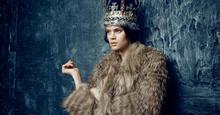Hugh Marr: Master Storyteller
In his upcoming book, Finding Your Story: Using Archetypes to Guide Your Personal Journey, Hugh K. Marr, Ph.D., tells a great story about the people of the Outer Banks of North Carolina, where he was raised and where his grandfather, Harold Overman, trained with country doctor Dr. William Poole.
In the early days of our country, Aaron Burr (of Hamilton fame) had a lovely daughter, Theodosia. Theodosia was married to the governor of South Carolina, Joseph Alston.
In June of 1812, she determined to travel to New England to greet her father, who had recently returned from a long stay in Europe. But her plans were thwarted when the couple’s young son contracted malaria and died. It took Theodosia six months before she felt up to the voyage. Finally, in December, she set sail from Charleston on the refurbished ship The Patriot. Aaron Burr eagerly awaited his daughter. Ships along the coast were often delayed, but the days turned into weeks; and the weeks turned into months. Neither Theodosia nor the ship on which she had booked passage was ever heard from again.
Many years later the physician Dr. William Poole was making his rounds among the poor villagers on North Carolina’s Outer Banks. The residents mostly cobbled together a living from fishing and from what few vegetables could grow in the salt air. But in earlier days, the “Bankers,” as they were called, had a much more lucrative income. On stormy nights they would take an old horse and tie a lighted lantern to its halter. They would march the horse up and down the sand dunes by the ocean shore. Ships out at sea, seeing the rising and falling light, would mistake it for another ship and turn toward it thinking they were headed to safe waters. Instead, they would run aground on the dangerous shoals. It was then that the Bankers—now land pirates—would storm the ship. Ships’ crews would be exhausted from the storm and wreck, and frightened. They would give up, usually without a fight. The pirates would gather all the plunder, then force passengers and crew alike to jump overboard into the roiling sea.
Dr. Poole doubtless knew of this history as he treated an ill Banker woman one night. The woman began a slow recovery. She could not pay Dr. Poole; in fact, Dr. Poole expected no payment. But she was appreciative, and insisted he take one of her heirloom treasures. It was a gilt framed oil painting of a lovely patrician lady. The subject of the portraiture was later identified as none other than Theodosia Burr.1
Marr’s grandfather was a lover of the historical stories of a place and its people. The stories his grandfather told, about the “Bankers” and “High Tiders” on the Outer Banks of North Carolina, seeded his own deep love of story. Marr carries on the ancestral line as a psychotherapist as he mines the inner history of a person, their place in time and the world, and the stories they tell.
Working with your life story eventually brings you face-to-face with the unconscious stories you have inherited, which in turn brings you face-to-face with fate. Your unconscious stories are the basic building blocks of fate; they are the symbolic blood and bones of our ancestors and the monsters they wrestled with. This level of story is imprinted in mannerisms, deep world views, and uncanny synchronicities, what C. G. Jung would call archetypal or primordial stories. In myth, the hero is the one tasked with discovering and transcending an inherited fate by confronting and overcoming the demons that plagued their people. Like a mythic hero, when we look deeply, we find the problems we struggle with are the same ones our parents, grandparents, and ancestors wrestled with, passing down their hard-earned wisdom.
There are two worlds, according to Marr, the world of objects and the world of imagination. Both worlds are equally real and valuable in human lives, but neither one can be defined by the other. “Stories are the crosswalk between the two worlds,” Marr said. “Stories are the way humans bridge and weave the worlds together.” This weaving is foundational work because both worlds are necessary to human beings; the world of objects is necessary to master reality and survive. The world of imagination is necessary to know and live the meaning of our lives, which is necessary to have a reason to survive.
To work with story is to work with the symbolic, metaphorical, and imaginative element of human identity. In this realm, your identity does not end at the precipice of your memory; it is not bounded by your time in history. In the realm of story, you live an enchanted life embedded in the mythic sway of human beings. The realm of story is embodied in the twelve Jungian archetypes of the Pearson-Marr system. In Finding Your Story (being released in October), Marr leads you down the spiraling path of time and psyche to your archetypal story, incorporating the Pearson-Marr archetypes and your specific Archetype profile from the PMAI® assessment.
Considering again the two worlds—objects in reality and meaning in imagination—in Finding Your Story the PMAI archetypes appear as the storied bridge connecting them. The archetypes are objects in reality as you assign archetypal roles to the important people who shaped you and your life. These same archetypes show up in their imaginative dress when Marr guides you to consider the mythic and symbolic plots of the chapters of your life story, or when he asks you to reimagine the outcomes of your past into the potential of your future. This is the beauty of the Jungian archetypes and Marr’s journey to foundational story: archetypes are symbolic and evolving, dynamic and creative, and you are the master storyteller weaving it all together.
Finding Your Story: Using Archetypes to Guide Your Personal Journey will be available for purchase in October! Sign up to receive emails from Storywell to be notified.
1. Marr, H. K. (2023). Finding Your Story: Using Archetypes to Guide Your Personal Journey. Myers & Briggs Foundation.




.png)
















_thumb.png)
_thumb.png)
_thumb.png)
_thumb.png)


